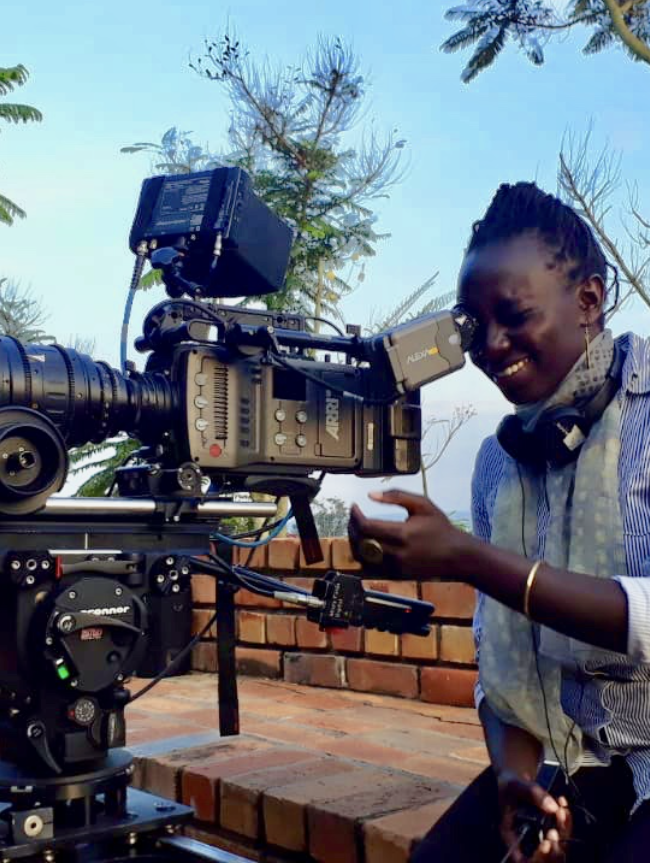A Conversation with Darcy McKinnon & Suzannah Herbert (NATCHEZ)
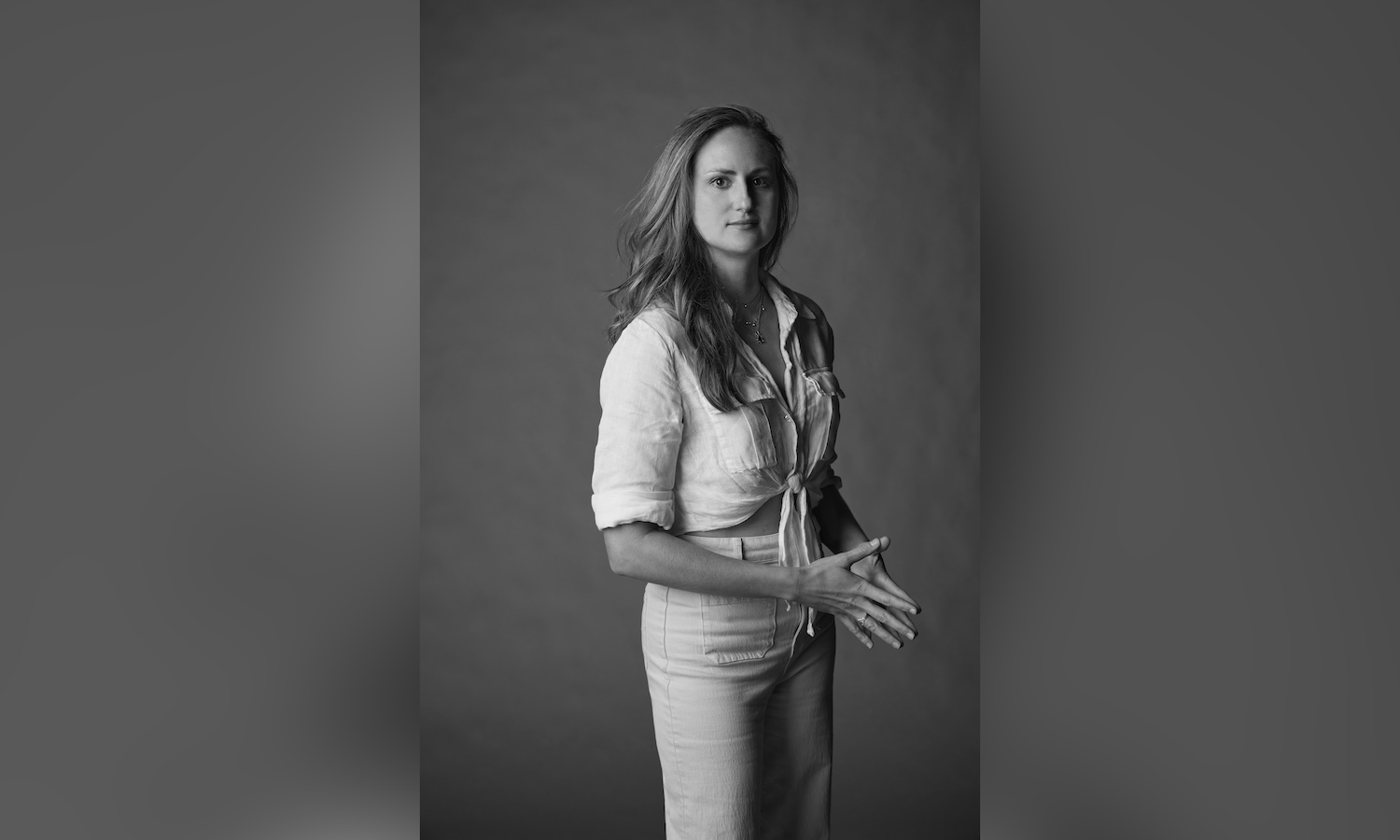
Director Suzannah Herbert’s most recent documentary, Natchez, just played the 2025 Tribeca Festival (where I reviewed it) and it won not only the best documentary feature prize but also special jury awards for cinematography. The movie delivers an intriguing portrait of the titular city in Mississippi, where residents clash over the area’s history. Many of the white proprietors of old mansions (which offer “pilgrimage” tours) have a romantic take on the past, while the African American inhabitants—at least one of whom, Debbie, has purchased and renovated a plantation slave residence (also with tours)—see the antebellum South through a far more critical lens. One of the main characters is Rev, a Black tour guide whose mission is to set the record straight. It’s an area in flux, with the potential for reconciliation always tantalizingly close. During Tribeca, I had the chance to speak with Herbert and her producer, Darcy McKinnon, via Zoom the day of their premiere. What follows is a transcript of that conversation, edited for length and clarity.
Hammer to Nail: I really liked the cinematography in this film, and I saw that Noah Collier, the co-director of another film I know, Carpet Cowboys, was your DP [Director of Photography]. How did that collaboration begin?
Suzannah Herbert: Thank you for watching the film and for doing this interview. So, Noah and I first met back in 2015 when I was making a film called Wrestle. It was my first feature and we needed a second cinematographer to come down and shoot in Alabama for our state championships. So Noah came down to Alabama 10 years ago, and that’s how I met him, and I loved working with him. There was a very lot going on and I just sent him off and he captured beautiful second camera of the climax of our film. We stayed in touch over the years, and then I started developing Natchez and I reached out to Noah a couple of weeks before doing our first development shoot in 2022, and he was down. He came to Natchez with us for every shoot; we shot about 75 days, though we were there a lot more. Our longest time shooting was six weeks straight, which was really intense.
Darcy MacKinnon: You guys were roommates for six weeks. (laughs)
SH: (laughs) We all lived in the same house. Every time we would go, we would stay in a different Airbnb.
DM: And I’ll just say he’s one of those rare people who’s both a cinematographer and a director. Not that that’s rare, but he joyfully took on the creative side of the film and worked with us. We had a very lean crew most of the time. It was Suze and one of our two sound recorders, Brian and Sean, plus Noah. He was always thinking about how to make sure that the visual look of the film matched the themes that we were working on. We shot the whole thing on sticks [a tripod or other fixed camera support], and we shot it on a Sony FX9 , so it wasn’t like a huge camera rig. And we were able to find, through a really nice camera house in New Orleans, a beautiful set of vintage prime lenses. And we used a lot of low shots, a lot of sticks with these beautiful lenses and a lot of really innovative techniques that Noah thought up.
SH: Yeah, he used this little thing … what was it?
DM: It’s like a little thing you get at the optometrist’s office. It’s like a little handheld magnifier that he would wave in front of the lens to get certain kind of muddled effects that I had never heard of before. And when they told me, I was like, “Excuse me, what?” We also hired a grip, and so for three days they mounted the camera on every kind of tourism vehicle that they could, for moving shots. It was a really fun collaboration, with this very small, intimate crew.
HtN: I really like those vehicle-mounted shots. You don’t always see that kind of camera work in a documentary.
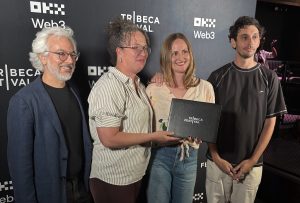
The NATCHEZ team at Tribeca. L-r: editor Pablo Proenza, producer Darcy McKinnon, director Suzannah Herbert, DP Noah Collier
SH: We did that towards the end of our shooting, once we knew we had the story in the can and we could have more fun with it. We blocked off three or four days just to do those mounted shots. And then Noah and I and Darcy, we talked a lot before we started shooting about the approach and that we were going to do the lenses. And we all watched Robert Altman’s Nashville, which we felt had a lot of similarities: there are so many characters; there’s a van that does the radio around town and you go from one scene to the other. And so that was definitely an inspiration. And we wanted to shoot Rev’s van in that same way. And we also had some days with a zoom lens.
DM: We wanted to use a very long lens and to have the van itself be a character that takes us from scene to scene throughout the town, because how to portray the physicality of this very small town was something we were thinking. How do you move through the spaces and places and understand the relational geography of it?
HtN: I’m glad you didn’t do Altman’s signature technique of overlapping dialogue, or else we might not understand what people are saying. So, how did the collaboration start between you two?
SH: Well, I started thinking about making a film about plantations and antebellum tourism in 2017 after I was invited to a wedding on a plantation. I’m from Memphis and I am very focused on Southern stories. My first film was in Alabama, and that’s what I’m passionate about. I knew Darcy’s work. Elaine McMillion Sheldon introduced us. I asked her, “Do you know any producers?” She is close friends with Darcy, so she was like, “You should talk to Darcy.” And so then I emailed Darcy and she can tell you what she said.
DM: Elaine and I met because a long time ago we tried to start the Southern documentary collective called “All Y’all” but found ourselves too busy to actually run it. It was a great way to connect and meet Southern filmmakers. Today, I usually rely on the Southern Doc Fund as a way to connect the network across states. I got the email introducing us, though I was not interested in a new film and was like, “Oh, here we go, another Brooklyn filmmaker making a film about the South.” But then I watched Wrestle and I also had the other women in my office watch Wrestle, and we were all in tears and were like, “Oh, this is the kind of project we want to be involved in.”
And I think also Suzanne’s care and intention and the artfulness of the storytelling is really compelling. As is this work of navigating how we are reclaiming our own, or how we are not allowing flattened representations of the places that we’re from to be part of the narrative, and how we’re working on our own narrative change. That is really what I’m interested in doing. So the fact that not only this is a story about a town in the South that’s trying to figure out its identity, but that it’s literally about storytelling, was really compelling to me, as well.
HtN: I really like Elaine McMillion Sheldon’s King Coal, as well as Heroin(e). Speaking of the filming techniques you mentioned earlier, I have a question about the archival footage. As I was watching the movie, I wondered if any of the archival footage we see—or ostensibly archival footage—was mixed in with subtle recreations. Because the footage sometimes seems to segue very nicely into modern-day shots.
SH: So we really don’t have a lot of archival in the film, but in the main section where we tell the history of pilgrimage, it begins with a shot that Noah shot, and then we put an effect on it to transition to the archival, and then we do the same for the last shot in that sequence: we put an effect on it, and then it transitions to the present day. But the stuff in between is totally all archival from the ‘40s and the ‘50s and the ‘60s.
HtN: So it wasn’t my imagination.
SH: I hope it felt smooth.
HtN: Absolutely. It’s very clever. I have another question about technique. It’s not uncommon for filmmakers to choose not to put onscreen titles—or what we also call “lower thirds”—on the frame to identify the speakers, and you choose not to. I’m always curious why people do or do not do that. We figure it out from context, but I’d love to hear why you made that decision.
SH: I feel like the context is enough and you don’t really need it. They are tour guides, so I felt like everyone introduces themselves and says their name, so I wanted it to feel like you were on tour with them.
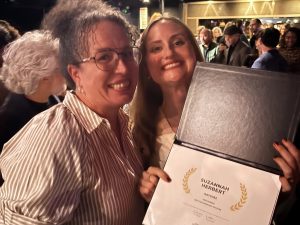
l-r: Darcy McKinnon & Suzannah Herbert celebrating their Tribeca win
DM: When we were planning the film, almost all the comparisons we’d use to describe what we were trying to do were all fiction. We talked about this as White Lotus-meets-Gone with the Wind, or Nashville. We also obviously took a lot from lots of documentaries, but when we thought about the way we wanted to craft the story, we wanted it to feel like you’re entering into a world in the way you do in a fiction piece. And so we didn’t want to use a lot of documentary tropes. Plus, another thing is that everyone in Natchez is a self-appointed expert, and so handing them expert status seems like an unnecessary step.
SH: And there are so many people in the film. I was like, “Where do we begin and where do we end?” I didn’t want to go down that rabbit hole.
HtN: Fair enough. I like that White Lotus-meets-Gone with the Wind pitch! So, there were some scenes of great onscreen discomfort in the film, and you lean into that because I think that’s what the film is about, these uncomfortable discussions. But one scene stood out to me where the white pilgrimage hosts are speaking to Debbie, the first African American woman to be invited into the Garden Club. I felt like that was a larger metaphor for the cluelessness of many of these folks. Have any of them seen the film? I’m curious about their self-awareness over the process of making this film, and if you’ve had conversations with them as you’ve completed the movie.
SH: We actually got back from Natchez a few weeks ago. We went down to show the film to the mayor, Dan Gibson, and Kathleen Bond, the National Park Service head, as well as Tracy McCartney and David Garner, who are all in the film. We showed it privately to each of those people. Rev and Debbie both felt very strongly that they wanted to wait until Tribeca to see it on the big screen.
HtN: So they’re seeing it tonight.
SH: So they’re seeing it tonight! We didn’t have a larger community screening yet because we want Debbie and Rev to see it first. But the reaction from everyone we showed it to has been extremely positive, and people were very moved and affected, I think, by the film.
DM: Kathleen, the park ranger, said, “How did you get the pulse of this place so quickly?” And actually, I think one of the more powerful parts of the film are all the people who are in between. If you look at Rev and Debbie and Kathleen as people who come to an expansive and more holistic view of history, and then you look at the homeowners, obviously David is in that category of people who are very much sticking to their guns about a particular narrative. For me, personally, as a lifelong Southerner, I’m interested in the ones in between who are doing what they can, as Kathleen says, with varying results, but who are doing that very, very difficult thing of trying to change their minds, what they’ve known their whole life, and what they learned from their own parents and grandparents. For me, that’s where the interesting part lies. Anybody who is not a main character hasn’t seen it yet, out of respect to Rev and Debbie. I’m thrilled they’re going to see it tonight. Our goal is to do a community screening this summer.
HtN: Speaking of the people who are in between, I really like that scene where Tracy, the woman with the blue hoop skirt, goes on a tour with Rev, whose name is also Tracy, and she encapsulates this idea of being open-minded enough to learn and revise. That’s in opposition to David, however. I’m surprised that you screened the film for David and that he had a positive reaction, given the reveal that you have embedded in those final scenes.
SH: His reaction was not necessarily positive but he said it was a very well-put-together film and that it could have been worse, and he thanked us for inviting him.
HtN: (laughs) Interesting. I do have a question about the reveal, though, because I wonder if David grew comfortable enough with a camera so that he would do that, or was he saying these kinds of things throughout the process, and then you as a filmmaker chose to only reveal those racist comments of his at the end?
SH: That moment was about a year-and-a-half into filming. It was the angriest he had ever gotten. So that was kind of surprising to me, that racist anger. But he had previously been on tour saying casual racism, but it wasn’t throughout the whole process.
DM: I think another thing we discovered through the process is that this is a well-known feature of his behavior. Other homeowners know it. The Garden Club knows it. The Visitor Center has gotten feedback about this stuff. He is who he is, and as he says in the film, “We live in a bubble”. And I don’t want to speculate on what he thinks, but he is who he is.
HtN: Even though I disagree with everything he says, I appreciate how you create this portrait of people as human beings. As filmmakers, you are generating some sympathy that we can’t help but feel, seeing this person with Parkinson’s struggle through that. But then you also show this side of him, and I do think that that’s representative of the great variety of behaviors in the human animal. And so I appreciate that three-dimensionality to the characters.
SH: That was very intentional and very much in collaboration with Pablo Proenza, our editor. He felt very strongly that we should give hints, and if you watch the film a second time—or you might have noticed the first time—there are hints throughout that he might have some of these feelings. But we really wanted to show David as a complex human.
DM: And he was also part of a community. For me, that’s what’s really interesting about Natchez, too, is it’s a community, which means people are constantly intersecting and engaging with each other. They depend on each other, and that’s what makes change difficult in many times, too, is that the status quo is the thing you know.
HtN: And yet, speaking of intersection, there’s that intersectionality of David as a member of the LGBTQ community, and yet he holds these racist views, apparently unaware of how his identity makes him just as much of a target, or he just chooses to ignore that fact. I really enjoyed the film and I really enjoyed your subjects. Was there anyone, or was there anything that you had to let go of in the editing because you just didn’t have room for it? Maybe something that particularly hurt to let go?
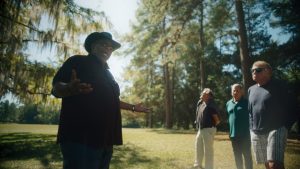
A still from NATCHEZ, with Rev on left.
SH: There’s so much! Yes! I mean, there are so many beautiful and interesting people there. We filmed with this woman, Mary Jane, who’s incredible. She’s an 85-year-old, eighth-generation Natchezian and just full of life; she volunteers with the Stewpot, bringing meals to people every day and is trying, as an 85-year-old white woman, to tell the history of slavery on these house tours. She’s incredible. But …
DM: And she’s still in the film. You see these little glimpses of people, briefly. The thing about Natchez is that for a town of just 15,000 people, it has such a place in America’s racial history, from its role in slavery to its role during the Civil Rights Era where the NAACP treasurer was blown up in a car—his son is still alive and in Natchez—to the imprisonment of Civil Rights activists in Parchman. There are so many stories that we could have focused on, but it felt really important, especially for Suzanne as a storyteller, to look at the myths of “the lost cause” and white supremacy that have crafted this relationship in this unique little town. And unfortunately, we had to leave a lot of that behind to get to this storyline.
HtN: Another thing I was curious to know about, watching your film, in terms of what’s going to happen in the future, was all of the National Park stuff, because of course, you don’t need me to tell you that we are now in a very different era where things are getting defunded. So what is happening to those plans to expand that national monument, Forks of the Road, the former slave-auction site?
SH: It is still happening as of right now, and there’s some stuff happening behind the scenes that we can’t talk about that is positive, but who knows? Yeah, it’s not great.
DM: Exactly what you think is happening is happening. There has been some furthering of the land-acquisition goals, because part of it is that the sliver you see is a very small piece of land. In order for it to become what they want it to become, they want to incorporate all of the things around it and also have enough space to build an interpretive experience. So they’ve been moving forward with land acquisition and had some things approved, but then they are experiencing what everybody’s experiencing. So it’s not shelved, but it’s not great.
HtN: Well, I’m glad to hear that it’s not shelved yet, at least. Thank you for bringing all these stories to light and to life. I really wish you great things with the film.
SH/DM: Thank you.
– Christopher Llewellyn Reed (@ChrisReedFilm)
2025 Tribeca Festival; Darcy McKinnon; Suzannah Herbert; Natchez interview









